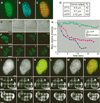Dynamics of single mRNPs in nuclei of living cells
- PMID: 15205532
- PMCID: PMC4765737
- DOI: 10.1126/science.1099754
Dynamics of single mRNPs in nuclei of living cells
Abstract
Understanding gene expression requires the ability to follow the fate of individual molecules. Here we use a cellular system for monitoring messenger RNA (mRNA)expression to characterize the movement in real time of single mRNA-protein complexes (mRNPs) in the nucleus of living mammalian cells. This mobility was not directed but was governed by simple diffusion. Some mRNPs were partially corralled throughout the nonhomogenous nuclear environment, but no accumulation at subnuclear domains was observed. Following energy deprivation, energy-independent motion of mRNPs was observed in a highly ATP-dependent nuclear environment; movements were constrained to chromatin-poor domains and excluded by newly formed chromatin barriers. This observation resolves a controversy, showing that the energetic requirements of nuclear mRNP trafficking are consistent with a diffusional model.
Figures



References
-
- Materials, methods, and additional data are available ?as supporting material on Science Online
-
- Tsukamoto T, et al. Nature Cell Biol. 2000;2:871. - PubMed
-
- Movies S1 to S23 are available at http://singerlab.org/supplements/science_v304p1797.
Publication types
MeSH terms
Substances
Grants and funding
LinkOut - more resources
Full Text Sources
Other Literature Sources

